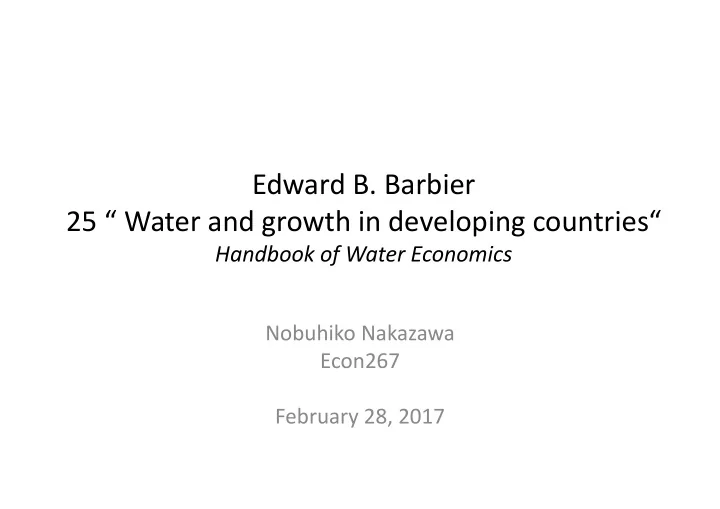

Edward B. Barbier 25 “ Water and growth in developing countries“ Handbook of Water Economics Nobuhiko Nakazawa Econ267 February 28, 2017
Background • Growing global water demand is forecast to occur mainly in developing countries. 2
Growing global water demand • The world is experiencing increased freshwater demand of about 64 billion m 3 per year (WWAP, 2012) • Global water demand is anticipated to rise significantly, from about 3500 km 3 in 2000 to nearly 5500 km 3 in 2050 (OECD,2012) • Water withdrawals are predicted to increase by 50 percent by 2025 in developing countries (UNEP, 2007) 3
Global Water Demand Source: OECD(2012) Note: GLOBAL WATER DEMAND (FRESHWATER WITHDRAWALS): The OECD’s 2012 Global Environmental Outlook’s Baseline Scenario, 2000 AND 2050 4 BRIICS (Brazil, Russia, India, Indonesia, China, South Africa); OECD (Organisation for Economic Co-operation and Development); RoW (rest of world). This figure only measures ‘blue water’ demand and does not consider rainfed agriculture.
Motivation • These trends in relative water use in developing economies raise the possibility that increasing water use may affect the growth of these economies. 5
Influences of increased water utilization on growth • The influences of increased water utilization on growth were explored by Barbier (2004) • positive influence – using ‘freshwater capital’ is beneficial to the economy, as this publicly provided good serves as a productive input to private producers. • Negative influence – the public investments in water institutions and infrastructure necessary to secure freshwater supplies for utilization are a cost – these costs rise as a country appropriates and purchases a greater share of aggregate economic output 6
Hypotheses • A key hypothesis that growth is positively influenced by the contribution of increased water use to productivity, leading to an inverted-U relationship between economic growth and the rate of water utilization. • The alternative hypothesis is that growth could decline with the rate of water utilization, or have a U-shaped relationship with water use. 7
Contribution • Estimate the relationship between water and growth • a panel analysis for 112 developing countries from the 1970s through the 2000s • Find U-shaped relationship 8
Empirical model • g t, t+5 = F(y t , h t, w t ) – g t, t+5 : a country’s five-year average per capita growth rate, beginning at initial year t – Y t : per capita GDP – h t : human capital – w t : water withdrawal 9
Control variables • economic variables – the ratio of domestic investment to GDP – the extent of international openness – agricultural share of GDP • geographical variables – land or surface area 10
Data • water data – AQUASTAT (FAO, 2013) • other economic and geographical data – World Data Bank – UNDP – UNESCO – Socrata Open Data 11
Panel analysis of water and economic growth in developing economies, 1970–2012 12
Main determinants on economic growth in developing economies, 1970–2012 13
Note: The scatter plot is based on the regression sample (254 observations) of estimation 5 in Table 25.1. The dotted line represents the partial relation between the growth rate of per capita income and the rate of water utilization based on estimation 5 and applied to the sample, and with all other variables of the estimation evaluated at their means. 14
Critique • Freshwater supplies and use rates vary considerably across the regions within a country. • Many rivers, lakes, groundwater aquifers and other water bodies often cross political boundaries. • Freshwater availability could be more problematic for key sectors in developing countries. • U-shape? 15
Conclusion • Increasing rates of water utilization in most developing countries have a significant and negative impact on overall economic growth. • Freshwater ‘capital’ should be included as an additional factor influencing growth. • The U-shaped relationship appears to be dominant. 16
Recommend
More recommend